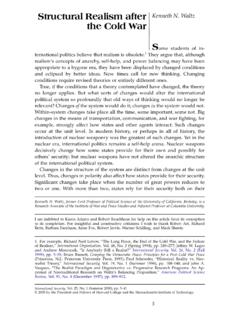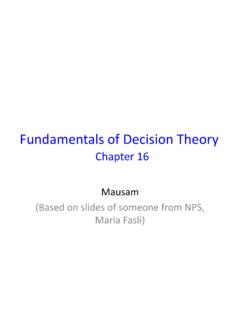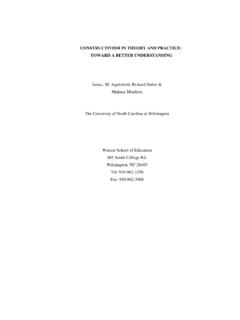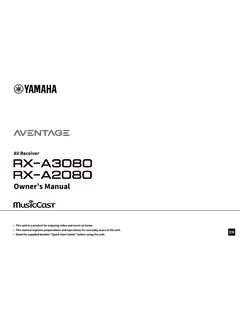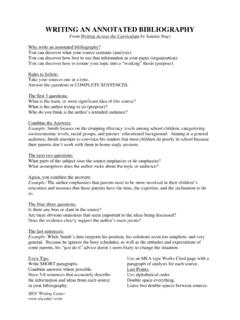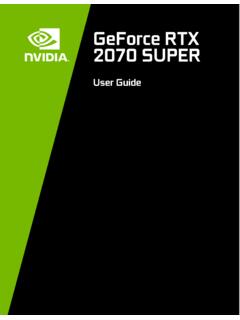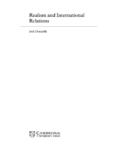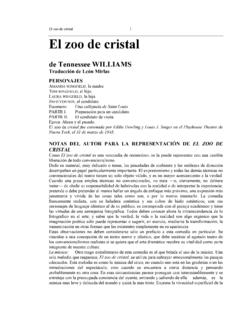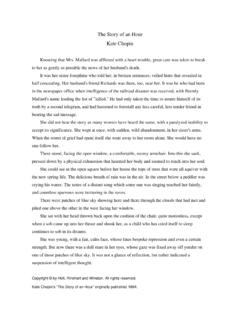Transcription of Introduction to quantitative research
1 1 Introduction to What is quantitative research ? research methods in education (and the other social sciences) are oftendivided into two main types: quantitative and qualitative methods. Thisbook will discuss one of these two main strands: quantitative methods ,and what distinguishes quantitative from qualitative methods. When you think of quantitative methods, you will probably have specificthings in mind. You will probably be thinking of statistics, numbers, andmany of you may be feeling somewhat apprehensive because you thinkquantitative methods are difficult.
2 Apart from the last one, all thesethoughts capture some of the essence of quantitative methods. The following definition, taken from Aliaga and Gunderson (2000),describes what we mean by quantitative research methods very well: quantitative research is Explaining phenomena by collecting numericaldata that are analysed using mathematically based methods (in particu-lar statistics) .Let s go through this definition step by step. The first element is explainingphenomena. This is a key element of all research , be it quantitative or quali-tative.
3 When we set out to do some research , we are always looking to explainsomething. In education, this could be questions like why do teachers leaveteaching? , what factors influence pupil achievement? , and so specificity of quantitative research lies in the next part of the defini-tion. In quantitative research , we collect numerical data. This is closely con-nected to the final part of the definition: analysis using mathematically18725 25/08/2010 16:36 Page 1based methods. In order to be able to use mathematically based methods,our data have to be in numerical form.
4 This is not the case for qualitativeresearch. Qualitative data are not necessarily or usually numerical, andtherefore cannot be analysed by using statistics. Therefore, as quantitative research is essentially about collecting numericaldata to explain a particular phenomenon, particular questions seem imme-diately suited to being answered using quantitative methods. How manymales get a first-class degree at university compared to females? What per-centage of teachers and school leaders belong to ethnic minority groups?Has pupil achievement in English improved in our school district overtime?
5 These are all questions we can look at quantitatively, as the data weneed to collect are already available to us in numerical form. Does this notseverely limit the usefulness of quantitative research though? There aremany phenomena we might want to look at, but which don t seem to pro-duce any quantitative data. In fact, relatively few phenomena in educationactually occur in the form of naturally quantitative , we are far less limited than might appear from the above. Manydata that do not naturally appear in quantitative form can be collected ina quantitative way.
6 We do this by designing research instruments aimedspecifically at converting phenomena that don t naturally exist in quan-titative form into quantitative data, which we can analyse of this are attitudes and beliefs. We might want to collect dataon pupils attitudes to their school and their teachers. These attitudesobviously do not naturally exist in quantitative form (we don t form ourattitudes in the shape of numerical scales!). Yet we can develop a question-naire that asks pupils to rate a number of statements (for example, I thinkschool is boring ) as either agree strongly , agree , disagree or disagreestrongly , and give the answers a number ( 1 for disagree strongly , 4for agree strongly).
7 Now we have quantitative data on pupil attitudes toschool. In the same way, we can collect data on a wide number of phen-omena, and make them quantitative through data collection instrumentssuch as questionnaires or tests. In the next three chapters, we will look athow we can develop instruments to do just that. The number ofphenomena we can study in this way is almost unlimited, makingquantitative research quite flexible. This is not to say that all phenomenaare best studied by quantitative methods. As we will see, whilequantitative methods have some notable advantages, they also havedisadvantages, which means that some phenomena are better studied byusing different (qualitative) methods.
8 The last part of the definition refers to the use of mathematically basedmethods, in particular statistics, to analyse the data. This is what peopleusually think about when they think of quantitative research , and is often2 DOING quantitative research IN EDUCATION WITH SPSS8725 25/08/2010 16:36 Page 2seen as the most important part of quantitative studies. This is a bit of amisconception, as, while using the right data analysis tools obviously mat-ters a great deal, using the right research design and data collection instru-ments is actually more crucial.
9 The use of statistics to analyse the data is,however, the element that puts a lot of people off doing quantitativeresearch, as the mathematics underlying the methods seems complicatedand frightening. As we will see later on in this book, most researchers donot really have to be particularly expert in the mathematics underlying themethods, as computer software allows us to do the analyses quickly and(relatively) Foundations of quantitative research realism , subjectivism and the paradigm wars Now we have defined quantitative research , it is a good idea to compare itwith qualitative research , to which it is usually put in opposition.
10 Whilequantitative research is based on numerical data analysed statistically, qual-itative research uses non-numerical data. Qualitative research is actually anumbrella term encompassing a wide range of methods, such as interviews,case studies, ethnographic research and discourse analysis, to name justsome examples. The difference between quantitative and qualitative research is often seenas quite fundamental, leading people to talk about paradigm wars inwhich quantitative and qualitative research are seen as warring and incom-mensurable fractions.










